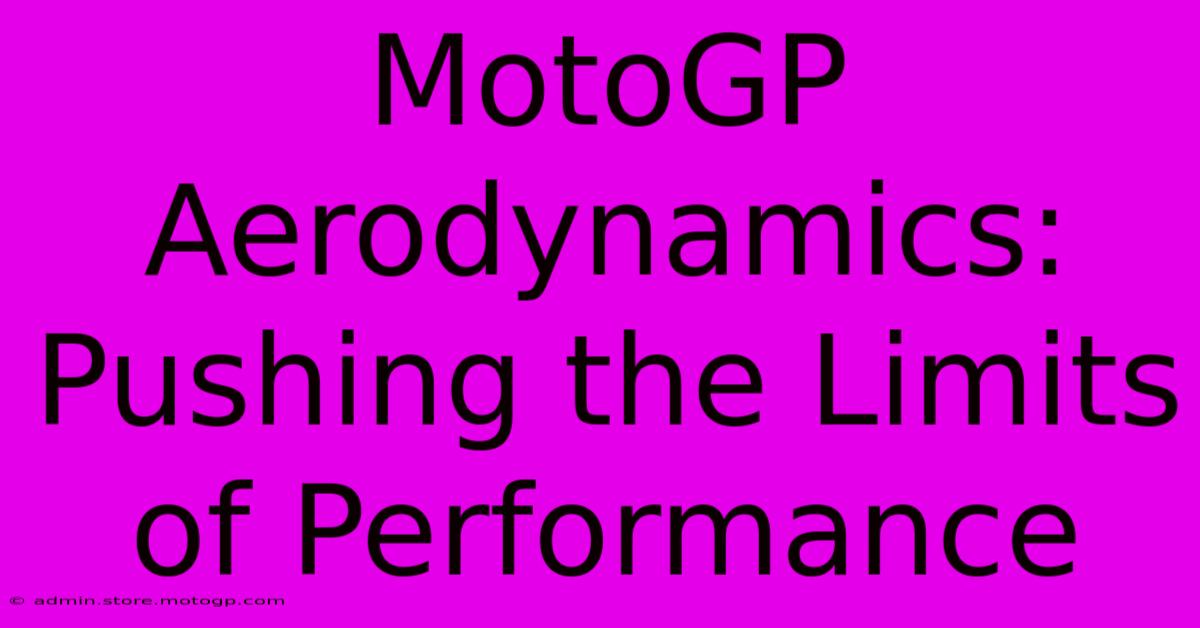MotoGP Aerodynamics: Pushing The Limits Of Performance

Table of Contents
MotoGP Aerodynamics: Pushing the Limits of Performance
MotoGP racing is a relentless pursuit of speed and performance. Every millisecond counts, and every aerodynamic advantage can mean the difference between victory and defeat. This article delves into the complex world of MotoGP aerodynamics, exploring the cutting-edge technologies and innovative designs that push the boundaries of what's possible.
Understanding the Aerodynamic Challenge
MotoGP bikes, traveling at speeds exceeding 200 mph (320 km/h), face immense aerodynamic forces. These forces, including drag and lift, significantly impact performance. Drag resists forward motion, slowing the bike down, while lift pushes the bike upwards, reducing tire contact and compromising stability, especially during cornering. The goal of MotoGP aerodynamics is to minimize drag while generating downforce – the opposite of lift – to keep the tires firmly planted on the track.
The Importance of Downforce
Downforce is crucial in MotoGP. It provides superior grip, enabling riders to accelerate harder out of corners and brake later, ultimately leading to faster lap times. This downforce is primarily generated through aerodynamic devices strategically positioned on the bike, including:
- Fairings: The motorcycle's bodywork, meticulously designed to channel airflow smoothly.
- Wings: These aerodynamic appendages, often found on the front and rear of the bike, generate significant downforce. Their design, angle, and size are constantly refined to optimize performance.
- Underbody Aerodynamics: The underside of the bike also plays a critical role. Carefully designed surfaces and tunnels manipulate airflow to increase downforce and reduce drag.
The Evolution of MotoGP Aerodynamics
Aerodynamic development in MotoGP is a continuous arms race. Teams constantly strive to refine their designs, often incorporating Computational Fluid Dynamics (CFD) simulations and wind tunnel testing to analyze airflow and optimize performance. The evolution has seen significant changes:
- Early Designs: Initially, fairings were primarily focused on streamlining.
- The Rise of Wings: The introduction of winglets and larger aerodynamic appendages revolutionized the sport, significantly increasing downforce.
- Sophisticated Designs: Modern designs incorporate complex geometries, often featuring intricate surfaces and strategically placed elements to manage airflow with greater precision. These innovations aim to reduce drag in high-speed sections while maximizing downforce in corners.
The Impact of Regulations
The governing body, Dorna Sports, imposes regulations on aerodynamic devices to ensure fair competition and safety. These regulations often limit the size and design of wings and other aerodynamic components. Teams must continually innovate within these constraints, leading to creative and highly sophisticated solutions.
Balancing Performance and Safety
While increased downforce enhances performance, it also introduces challenges. Excessive downforce can make the bike difficult to handle, particularly at lower speeds. The balance between performance and rider control is a crucial consideration in aerodynamic design. Safety is paramount, and regulations aim to mitigate the risks associated with high downforce levels.
The Future of MotoGP Aerodynamics
The pursuit of aerodynamic perfection in MotoGP is ongoing. Future developments will likely focus on:
- Advanced Materials: Lighter and stronger materials will allow for more complex designs and potentially greater downforce generation.
- Active Aerodynamics: Systems that adapt aerodynamic elements in real-time based on track conditions and riding style are being explored, promising even greater performance optimization.
- Further Refinement of Computational Tools: CFD simulations and wind tunnel testing will continue to play a crucial role, pushing the boundaries of aerodynamic understanding.
In conclusion, MotoGP aerodynamics is a fascinating field that constantly pushes the limits of engineering and technology. The quest for every marginal gain in speed and handling makes it a critical factor determining success on the track. As technology continues to advance, we can expect even more dramatic advancements in MotoGP aerodynamics in the years to come. The relentless pursuit of optimal aerodynamic performance ensures the continued evolution of this thrilling motorsport.

Thank you for visiting our website wich cover about MotoGP Aerodynamics: Pushing The Limits Of Performance. We hope the information provided has been useful to you. Feel free to contact us if you have any questions or need further assistance. See you next time and dont miss to bookmark.
Featured Posts
-
Risk Vs Reward The Dangers Of F1 And Moto Gp
Feb 20, 2025
-
Sprint Race Austin A Test Of Endurance
Feb 20, 2025
-
The Future Of Electric Circuit Racing
Feb 20, 2025
-
Experience The Diversity Of The Queen Circuit
Feb 20, 2025
-
The Ultimate Guide To Motorbike Racing Disciplines
Feb 20, 2025
